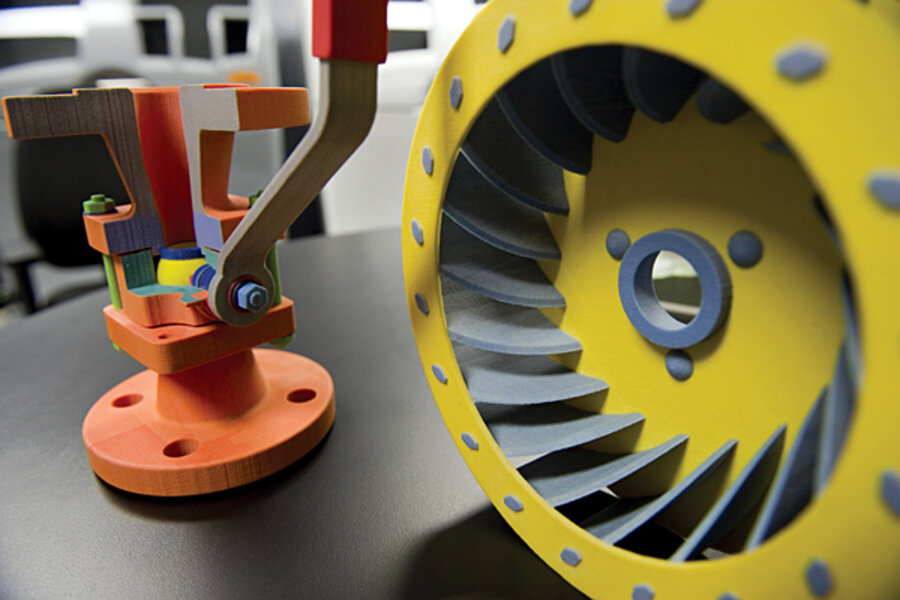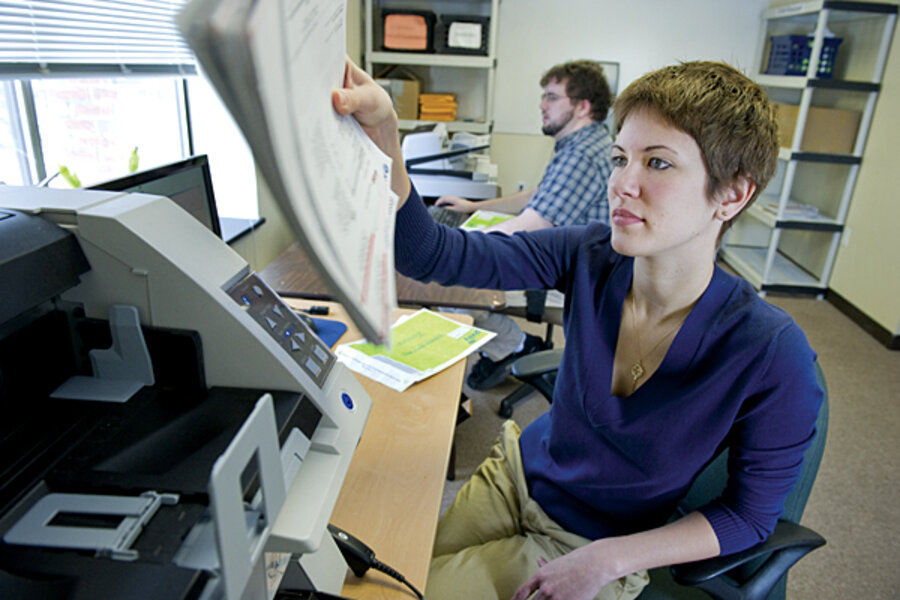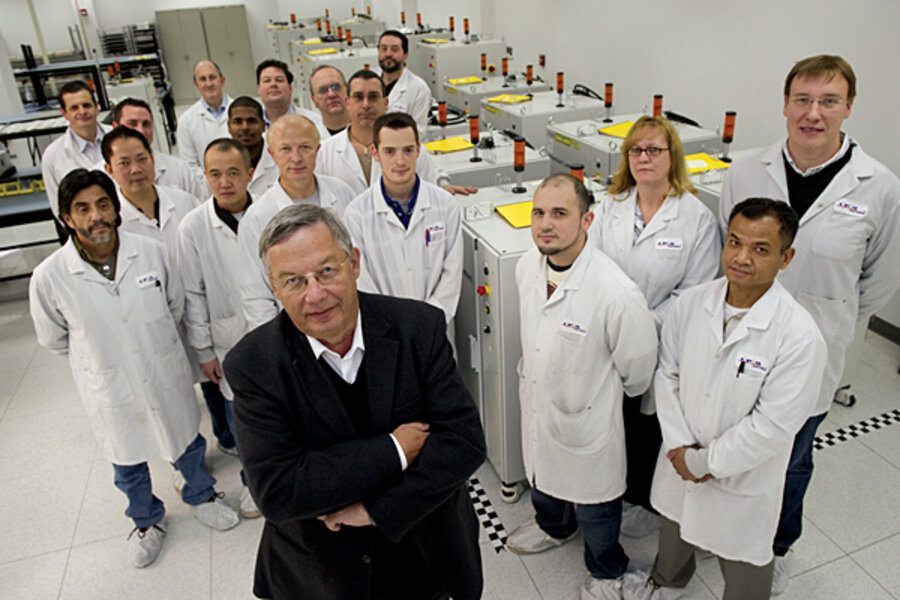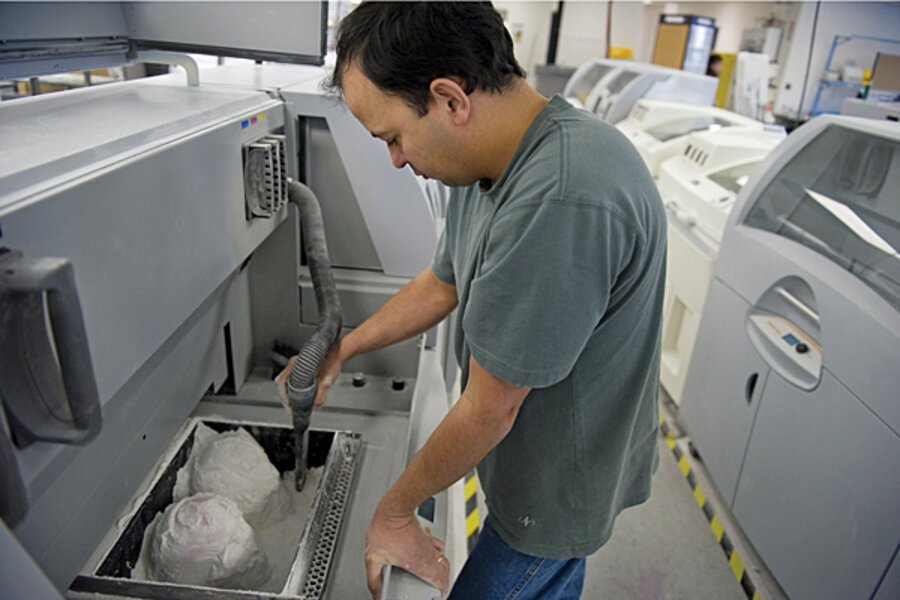How America can create jobs
Loading...
| Oxford, Mass.
If America is going to mount a solid recovery in jobs coming out of its deep recession, much of the fuel will come from people like Valentin Gapontsev, a Russian immigrant with a thick accent and a knack for turning beams of light into cash.
The company he heads isn't on the Fortune 500 list. It isn't located in a fancy mirror-skinned office building in downtown Boston. Instead, it resides down a blink-and-you'll-miss-it rural driveway, in a modest building where workers perform their tasks in white lab coats.
Yet the firm he founded, IPG Photonics, is putting this quiet community at the forefront of 21st-century laser technology. A decade after the IPG facility opened its doors in Oxford, Mass., nearly 400 people are now employed making equipment that manufacturers use for drilling, cutting, and welding metal parts – everything from car roofs to jet-engine combustors.
"Our target within 10 years is to triple our business, minimum," says Mr. Gapontsev, as he gazes from a conference room at the snow-gauzed woods outside.
Can you bottle what Valentin Gapontsev does? Is he one of a kind, or are there millions of Americans still out there whose skill, passion, and belief in the future has survived the worst battering since the bread lines of the 1930s?
Just saving American business from catastrophe was a heroic enough task over the past two years. Now, however, the focus has shifted to that one-syllable mantra that is the fundamental building block of economic growth: jobs.
Economists see firms like Gapontsev's – young, innovative, hungry – as crucial to job creation. What IPG Photonics does will have to be replicated exponentially across the country in everything from online start-ups to spade-in-the-ground food operations if the US is to put people back to work and raise living standards.
Innovative entrepreneurialism has always been at the core of America. It may now be the best hope for the return of the country's self-confidence – or at the least, for simply putting Americans back to work.
"We want companies that are going to double in size and growth in the next five years," says Elaine Allen, a professor of entrepreneurship at Babson College near Boston.
The idea isn't lost on President Obama and other policymakers seeking an employment fix. The president has recently been selling a raft of proposals designed to boost both innovation and small-business job creation. Among them:
•A tax credit for new hiring this year, with the benefits targeted especially toward small firms.
•Making the research and experimentation tax credit permanent, to become an $82 billion spur for innovation and investment this decade.
•Enlarging the pool of creative talent and skilled workers by revitalizing community colleges and making college loans more affordable.
Behind these moves lies a simple reality: The economy's net job losses over the past year have stemmed less from people losing their positions than from a sharp slowdown in the usual pace of new hiring – both by start-ups and long-established firms. During the recession, the number of jobs in the United States shrank by more than 8.4 million. The nation now has fewer private sector jobs than it did a decade ago, even though the population has grown by more than 20 million.
With that gaping jobs deficit, Mr. Obama's proposed incentives for bootstrap businesses are at best a partial fix. Many economists worry that the normal growth cycle may be too tepid to bring down the nation's 9.7 percent unemployment rate this year. So the president is pursuing more government aid to households and state governments, to give the economy a demand-side boost. He's also seeking to promote exports and to expand infrastructure spending.
Economists generally support this kind of multiprong strategy, but the basic goal is to get the economy's natural job-creation forces working again. The hiring will need to come from all quarters, including giant corporations and the hair salon down the street. Yet year in, year out, a healthy share of it comes from entrepreneurs, an American resource that dates back to Robert Fulton's steamboat.
So the questions loom: Where are the new
Valentin Gapontsevs? How can America regain its entrepreneurial edge? Even more fundamentally, does the nation still have an innovative culture?
The encouraging news is that it does: America's tradition of garage-to-riches start-ups, extending from Alexander Graham Bell to Jeff Bezos, remains relatively vibrant. Successful entrepreneurs exist everywhere from the mountains of Montana to the glass-and-steel canyons of Chicago. Today they are more globally connected than start-up firms have ever been. They span every industry, not just high-tech fields like lasers. Many of the founders are immigrants, and their ranks are being expanded increasingly by women, minorities, and people over age 50.
Nor have the innovative ideas stopped flowing just because of a deep recession:
•In Kokomo, Ind., a city hit by the travails of the US auto industry, a new company called Zuna Infotech is hiring more than 100 people with computer skills. The firm is serving clients who want to outsource their information-technology work, but in this case the jobs will be "onshore" in the US rather than in cubicles in India.
•Across the Southwestern US, Sprouts Farmers Market is turning home-grown cauliflower and navel oranges into big profits. Its concept – grocery stores that buy as much produce as possible from local farmers – has landed the Phoenix firm on Inc. magazine's list of fast-growing privately owned firms, yielding 2,500 jobs in just eight years.
•In the Boston area, a start-up called Pixily is growing jobs by helping small businesses ditch their file cabinets and store their documents digitally. Founder Prasad Thammineni, a serial entrepreneur from India, says he expects to double his payroll this year to about 20 employees.
"Being able to find information efficiently is the reason [businesses] find the service useful," says Mr. Thammineni.
Like many entrepreneurs, he stumbled on the idea for a business while trying to solve a problem – figuring out how to store his graduate-school notes. But what defines an entrepreneur is turning an epiphany into a viable product. In this case it took some nimble software, developed by a Pixily cofounder, that offers a no-fuss way to process all the documents that clients mail in monthly.
These kinds of employers represent the spearhead of job creation, even if many of them fail. "There's no question that they [high-growth firms] are critical to recovery," says Rob Atkinson, head of the Information Technology and Innovation Foundation, a think tank in Washington. "Their role in job creation is just so great."
The American fascination with entrepreneurs and inventors goes back at least to the days of Benjamin Franklin, the creator of bifocals and a wood stove. A confluence of forces contributed to the rise of a start-up culture. The young society blended egalitarian openness with acquisitive ambition. People had faith that they could achieve new things, but also a willingness to borrow ideas from an innovative Europe. The efforts fed on themselves as the nation developed a world-leading education system.
Despite its importance in American culture, the link between entrepreneurs and job creation is still only partially understood. Some analysts attribute the vast bulk of America's net job creation to start-up firms. But as vital as they are, it would be misleading to view them as the predominant source.
Modern economies are vast webs, where firms of all ages and sizes play important roles. Large firms, for example, often have the labs and know-how to be leaders in their fields. They usually provide better pay and benefits than smaller firms.
Still, firms in their first year account for about 3 in every 100 jobs at any given moment, according to recent research by the Census Bureau and the Kauffman Foundation. That's an enormous number – higher than the economy's net job creation in a typical year. Meanwhile, some of the start-ups that survive become big job creators as they aspire to be the next Facebook or FedEx.
Newer companies matter for another reason. Although plenty of innovations emerge from research labs at übercorporations like IBM, entrepreneurial firms tend to be founts of creativity. Miles Flamenbaum, for example, is helping truck fleets do more with less on vehicle maintenance. He heads a company, SOMS Technologies, that sells "microGreen" oil filters that allow cars and trucks to go up to 30,000 miles without an oil change. It's a product that's environment-friendly and can appeal during tough economic times.
"You can start saving [money] within that first 3,000 miles," says Mr. Flamenbaum, who launched the Valhalla, N.Y., firm in 2006 with the slogan: "Change your filter, not your oil."
True, innovation can lead to fewer jobs. If people are changing their oil less often, gas stations and Jiffy Lubes might have less business. Many new products marketed to US consumers are also as likely to create jobs overseas as in the US.
Still, the fact is, innovation usually leads to greater employment, not less. Someone, after all, has to staff the new oil filter business. Plus, as productivity and personal income rise as a result of innovation, consumers have more money to spend on other goods and services.
Innovation can create whole new industries, or enhance job opportunities within an industry. A quotidian example may be baby-sitting. Genevieve Thiers came up with the idea to found SitterCity, an online network to connect parents with sitters, as a college student. The year was 2001. Launching right after the dot-com bust (and as a music/English double major no less), she says she was "laughed out of the room" when she first sought start-up funds from investors.
After a bootstrap start, SitterCity has become a nationwide success. The firm currently employs 30 full-time people, with more on the way. But its bigger impact on the job market may be in home offices and high school lounges across the country. SitterCity's website now lists more than a million available caregivers, 45 percent of whom say they're now considering it as a career.
Ms. Thiers's service is essentially allowing people to create their own jobs: Her site now offers a gamut of home services, from elder and pet care to tutoring and baby-sitting.
Innovation can come in ways that benefit workers as much as consumers. Along the frothy Yellowstone River in Livingston, Mont., a business called PrintingForLess.com could also deserve the name "working for more." Providing an attractive office environment is integral to Andrew Field's recipe for print-shop success.
The company is known locally for its semicasual dress code, in-house day care, and dog-friendly policy inspired by Mr. Field's own border collie. These perks are matched by higher-than-average salaries, plus healthcare benefits. A person who works three 12-hour shifts a week can earn between $50,000 and $60,000 a year.
Field says this investment in keeping employees happy pays huge dividends by creating less turnover. That, coupled with his vision for reaching customers far beyond the northern Rockies with his online commercial printing operation, has spawned a robust business. The 14-year-old company has gone from 11 employees a decade ago to 130 today.
"We put a premium on high performance," says the denim-clad Field. "We tell our applicants that they shouldn't mistake the appearance of people walking around in boat shorts, flip-flops, and dogs lying at their side with a casualness in execution. You need to be smart and motivated to work here."
So if start-ups are still starting and inventive minds are still inventing, what's the problem? In a word: money. Economists and businesspeople say it's one of the worst climates for entrepreneurs in decades. The slowdown in consumer spending is coupled with a credit crunch.
True, in official pronouncements, Washington authorities and some pundits suggest that the credit crisis has been easing over the past year. But don't tell that to John Joyce.
"I'm not seeing credit freeing up," says Mr. Joyce, who runs the Small Biz Nest, which helps young companies with marketing strategies. "The consensus is that this is the toughest [business climate] they've seen."
He sees the evidence right in the business park where he works in Shirley, Mass.: the printing firm that's profitable but was turned down for a loan to buy equipment; the painter whose American Express limit was cut back, removing a cushion that had helped him bridge gaps between revenues and payroll costs.
Some start-ups simply aren't getting started. Others are building their businesses more slowly than might otherwise be the case. In New York City, Vinicius Vacanti and Jim Moran are launching an e-mail-based service that sends consumers a customized bargain alert each week, tailored to their preferences for anything from stiletto heels to sit-down dinners. Launching in a recession, they aren't rolling in seed money for their firm, Yipit.com. "We practiced the lean start-up methodology," says Mr. Vacanti.
That means no employees right now (aside from one intern) and a focus on proving their business concept in just New York first. And they count themselves among the fortunate start-ups, having a friends-and-family network that has provided early funding.
Venture capital firms, in a recent survey, say they expect 2010 to be better for their industry than 2009 was. But that's not saying much. The survey, by the National Venture Capital Association, also found firms expecting a protracted weak environment.
"Venture capitalists will have to do more with less," Mark Heesen, president of the association, said in releasing the results in December.
Uncertainty about the policy landscape also poses challenges for new companies and small businesses. While proponents of the Obama administration's healthcare reforms argue that they will ultimately help the nation's economy, if passed, the bills would also impose new mandates on employers to pay for health coverage.
Another problem facing start-ups is the "brain drain" to other nations. America continues to educate and attract many highly skilled immigrants, who are among the most likely to help launch high-growth firms. But many others are now going elsewhere to study or returning home after attending college in the US.
Despite all the challenges, the US enjoys considerable strengths in its innovation economy. First, as the world's premier bastion of consumerism, there is no better place to give new products a try. Columbia University economist Amar Bhide believes traditional theories of economic growth overestimate the role of scientific research and underestimate the role of "venturesome" consumers, people who take risks alongside the entrepreneurs by trying new products.
Second, businesspeople in America excel not just at technology but also on the "softer" side of innovation, the art of managing people. The success of Field's printing business in Montana doesn't stem simply from the confluence of the Internet and high-tech color presses. It's also his customer service, embodied in three-person teams that take each print job from start to finish.
Third, the US sports an array of supportive institutions, from university research labs to "incubator" business parks that offer low-cost office space and mentoring. Z Corporation, based near Boston, sprang up because the Massachusetts Institute of Technology (MIT) created technology for hitting a "print" button for three-dimensional objects.
If a 3-D printer sounds like something out of Willie Wonka's fantastical candy factory, just replace the confectioners' sugar with a less appetizing kind of white powder. The little granules get molded into any imaginable colorful shape – from prototypes of shoe soles to architectural models.
"We've developed our own patent portfolio" since licensing the initial technology from MIT, says CEO John Kawola, whose 15-year-old firm now has 130 employees.
Many US start-ups are also increasingly "born global" – with blueprints that recognize customers might be in Sydney, Australia, and parts suppliers in Seoul, South Korea. Take IPG, the laser firm. As the company grows, new jobs could be added not just in the US but in the firm's Russian or German operations – or elsewhere. Gapontsev says his choice of locations hinges on two issues: finding top talent to hire and having access to key markets for his products.
His own Russian roots are a reminder that the US has never had any patent rights on ingenuity. As a scientist in Russia shortly after the Soviet Union collapsed, he became convinced that optical fiber could be the conduit for delivering much more laser energy than others believed to be feasible – and through a flexible cable ideal for computer-guided movements on the factory floor. Pursuing his vision, Gapontsev laid the groundwork for a company that has seen sales grow from $61 million in 2004 to $229 million in 2008, according to Deloitte, the accounting firm. "For America, there is only one way to compete with Asia," says Gapontsev – automate wherever possible.
It's clear that the rest of the world won't be standing still. The challenge for the US, as it tries to recover from this recession and achieve longer-run prosperity, is to nurture even more entrepreneurship. As Mr. Atkinson puts it: "We need the US economy to keep reinventing itself."
• Todd Wilkinson contributed to this report from Livingston, Mont.









